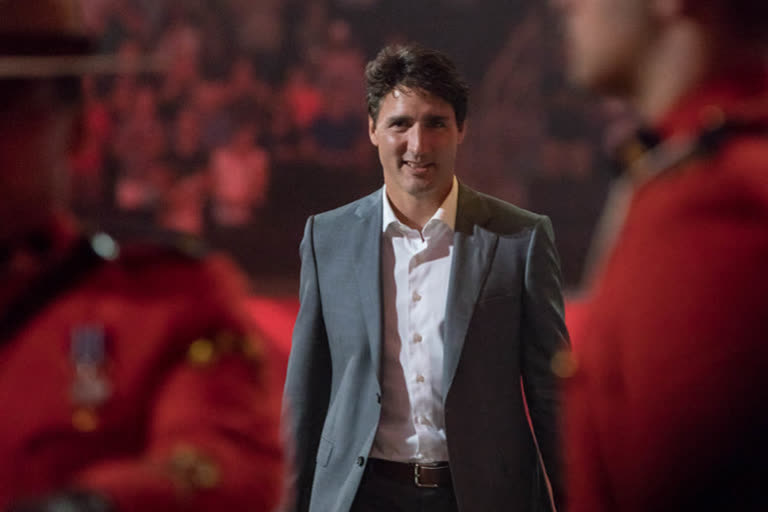Hyderabad: The Liberal party of Canada led by Prime Minister Justin Trudeau was widely expected to lose a parliamentary majority in the general elections held on 21 October. The results vindicated the opinion polls. The ruling party’s tally fell by 20 seats to 157 (out of 338) short of a simple majority. Though the Conservatives – the principal opposition party – secured more votes than the Liberals, they could muster just 121 seats, under a first-past-the-post electoral system, like that in India.
Yet few had anticipated that in the bargain, the country would see the emergence of an Indo-Canadian kingmaker who leads the leftist NDP (National Democratic Party) with 24 MPs. New Delhi should have been rejoicing but for a ‘minor’ detail that the concerned individual - Mr. Jagmeet Singh - is a vocal Khalistani sympathizer and a habitual India baiter. The forthcoming minority Trudeau government, dependent on NDP and / or Bloc Quebecois (the 3rd largest party), for issue-based outside support, thus does not augur well for India Canada ties.
If any two countries were meant to be the natural and close partners, arguably they were India and Canada. The synergies and commonalities between the two are striking - multi-ethnic, multicultural, robust democracies, English speaking, following rule of law, diasporic ties, complementary economies and educational linkages, to name just a few. However, providence appears to have willed it otherwise. Except for short periods of bonhomie, we have been at odds with each other.
It sounds incredulous, yet the fact remains that Mr. Narendra Modi, was the first Indian prime minister to visit Canada in April 2015 after a gap of 42 years. Lifting of the nuclear cloud, consequent to the painstaking conclusion of the bilateral civil nuclear cooperation agreement in 2010, enabled the landmark visit to materialize which was hugely successful in every regard. For the first time the Canadian government led by Conservative Prime Minister Stephen Harper publicly pledged to uphold the unity and integrity of India. It looked as if both sides had turned a new leaf in the ties.
The general election in October 2015 however, brought the youthful and telegenic Justin Trudeau to power with a thumping majority. PM Modi was one of the first leaders to make a congratulatory call and extend him a warm invitation to visit India. But, the popular new incumbent, who had lent his ear to Khalistani elements within his government and party, had other ideas.
Grateful for the wholehearted endorsement – financial, political and vocal - by the Sikh community in Canada, who refer to him as ‘Justin Singh’ he allocated heavy weight portfolios including that of Defence Minister to Mr. Harjit Singh Sajjan. He went all out to seal his Sikh vote bank, mostly controlled by the Khalistani elements, who provide the foot soldiers and generous donations to friendly politicians, during the electoral campaigns. They have managed to wrest administrative and financial control of many cash-rich Canadian Gurdwaras and are not bashful of using these resources to further their separatist agenda. The Canadian administrations have conveniently been looking the other way.
Historically the Sikhs in Canada have voted for the Liberal party in overwhelming numbers. During the Punjab problem in the 1970s and 1980s, Prime Minister Pierre Trudeau, father of Justin Trudeau, flung open Canadian doors for foreign nationals especially immigrants from Punjab. A large number of Sikhs migrated to Canada during this period, often claiming political persecution back home.
Migration of Punjabis (mostly Sikhs) to the west coast of Canada, began at the dawn of the 20th century. Another wave, as noted above, took place in the 1970s and 1980s. Currently Indo Canadian including those who migrated from eastern Africa add up to about 1.5 million (4% of Canadian population). Hindus comprise about 1 million and 500,000 are members of the Sikh community. The Hindus are spread across the country and prefer to vote on merit. The Sikhs are concentrated in Toronto suburbs such as Mississauga and Brampton, Vancouver suburbs such as Surrey and Calgary.
This enables them to shape the outcome in 8 to 10 constituencies (riding) and impact the outcome in an equal number of additional ridings. The current Parliament has 18 Sikh MPs (13 in India) and Punjabi has become the fourth most spoken language in Canada. The clout of the community can be judged from the following episode.
For the first time, the Public Report on the Terrorism Threat to Canada, released in late 2018 noted –“Some individuals in Canada continue to support Sikh (Khalistani) extremist ideologies and movements.” The resultant hue and cry from the Khalistani elements forced the government to drop all references to Sikh extremism in April 2019. Punjab Chief Minister Captain Amarinder Singh didn’t mince his words – the Canadian “government has taken this decision under political pressure ….. Trudeau is playing with fire as the decision will hit Indo-Canadian ties. Removal of Sikh extremism will also pose a threat to India's national security".
Announcement of the new cabinet is taking longer than usual as negotiations with NDP and Bloc Quebecois are underway, to tie-up outside issue-based support. All the same, as on the last occasion, four Sikh cabinet ministers are likely to be sworn-in. It is a different matter that being a minority government it is unlikely to last its full term of 4 years.
Earlier this year the Canada's intelligence services, leaked a secret report about Chinese and Indian governments working with diaspora communities in Canada to influence the October 21 elections. No evidence or justification was made public. This development mirrors the state of affairs between the two capitals. In short, under the current dispensation in Canada, official engagement is likely to remain tepid, while economic and people to people exchanges should limp along.
By Former Indian diplomat Vishnu Prakash




